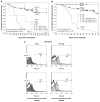Control of graft-versus-host disease with maintenance of the graft-versus-leukemia effect in a murine allogeneic transplant model using retrovirally transduced murine suicidal lymphocytes
- PMID: 17577932
- PMCID: PMC4075062
- DOI: 10.1016/j.exphem.2007.02.008
Control of graft-versus-host disease with maintenance of the graft-versus-leukemia effect in a murine allogeneic transplant model using retrovirally transduced murine suicidal lymphocytes
Abstract
Objective: Limited clinical trials have validated the hypothesis of controlling graft-versus-host disease (GVHD) arising from stem cell transplant utilizing suicidal T-lymphocytes that have been transduced to express the HSV-TK gene. However, clinical utility has been limited by diminished T-cell function arising from the production process. To evaluate strategies for harnessing the graft-versus-leukemia (GVL) effect while improving the safety and function of suicidal lymphocytes, we have developed techniques to produce fully functional, retrovirally transduced, HSV-TK-positive murine T cells (TK+TC).
Methods: Utilizing a murine major histocompatibility complex-matched transplant model, we evaluated the ability of TK+TC to generate a GVL effect and the ability to control GVHD in experiments where we varied the dose of TK+TC, ganciclovir (GCV) dose, the start of GCV administration (day 4, 7, 10, 13, 15, or 19) posttransplantation, and the GCV administration route (osmotic pump versus intraperitoneal).
Results: At TK+TC doses in excess of the standard lethal dose (SLD) of unmanipulated T-cells, GCV administration completely (2 x SLD) and partially (4 x SLD) controlled GVHD. Additionally, GVHD remained reversible despite delaying administration of GCV for a week after GVHD developed. Importantly, GVHD was controlled with a 1-log but not 2-log reduction in GCV dose, and this "partial suicide" preserved more circulating TK+TC compared with standard-dose GCV. Survival of leukemia-positive mice receiving TK+TC and GCV was significantly increased compared with control cohorts not receiving GCV or transplanted with unmanipulated T cells, thereby demonstrating a GVL effect.
Conclusion: Retrovirally transduced suicidal lymphocytes generate a potent GVL effect while simultaneously enabling control of GVHD, which results in improved leukemia and GVHD-free survival.
Figures







Similar articles
-
Preemptive control of graft-versus-host disease in a murine allogeneic transplant model using retrovirally transduced murine suicidal lymphocytes.Cancer Res. 2001 Apr 15;61(8):3355-60. Cancer Res. 2001. PMID: 11309292
-
Graft-versus-leukemia effect after suicide-gene-mediated control of graft-versus-host disease.Blood. 2002 Sep 15;100(6):2020-5. doi: 10.1182/blood-2002-01-0161. Blood. 2002. PMID: 12200361
-
Elimination of leukemia in the absence of lethal graft-versus-host disease after allogenic bone marrow transplantation.J Immunol. 2003 Mar 15;170(6):3046-53. doi: 10.4049/jimmunol.170.6.3046. J Immunol. 2003. PMID: 12626559
-
Th2 and Tc2 cells in the regulation of GVHD, GVL, and graft rejection: considerations for the allogeneic transplantation therapy of leukemia and lymphoma.Leuk Lymphoma. 2000 Jul;38(3-4):221-34. doi: 10.3109/10428190009087014. Leuk Lymphoma. 2000. PMID: 10830730 Review.
-
Strategies for Enhancing and Preserving Anti-leukemia Effects Without Aggravating Graft-Versus-Host Disease.Front Immunol. 2018 Dec 21;9:3041. doi: 10.3389/fimmu.2018.03041. eCollection 2018. Front Immunol. 2018. PMID: 30619371 Free PMC article. Review.
Cited by
-
Imaging of Sleeping Beauty-Modified CD19-Specific T Cells Expressing HSV1-Thymidine Kinase by Positron Emission Tomography.Mol Imaging Biol. 2016 Dec;18(6):838-848. doi: 10.1007/s11307-016-0971-8. Mol Imaging Biol. 2016. PMID: 27246312 Free PMC article.
-
Preparing clinical grade Ag-specific T cells for adoptive immunotherapy trials.Cytotherapy. 2007;9(7):613-29. doi: 10.1080/14653240701650320. Cytotherapy. 2007. PMID: 17943498 Free PMC article. Review.
-
Metabolic Pathways in Alloreactive T Cells.Front Immunol. 2020 Jul 24;11:1517. doi: 10.3389/fimmu.2020.01517. eCollection 2020. Front Immunol. 2020. PMID: 32793207 Free PMC article. Review.
-
Graft-versus-leukemia effect of HLA-haploidentical central-memory T-cells expanded with leukemic APCs and modified with a suicide gene.Mol Ther. 2013 Feb;21(2):466-75. doi: 10.1038/mt.2012.227. Epub 2012 Nov 13. Mol Ther. 2013. PMID: 23299798 Free PMC article.
-
Repetitive noninvasive monitoring of HSV1-tk-expressing T cells intravenously infused into nonhuman primates using positron emission tomography and computed tomography with 18F-FEAU.Mol Imaging. 2009 Jul-Aug;8(4):230-7. Mol Imaging. 2009. PMID: 19728977 Free PMC article.
References
-
- Biggs JC, Horowitz MM, Gale RP, et al. Bone marrow transplants may cure patients with acute leukemia never achieving remission with chemotherapy. Blood. 1992;80:1090–1093. - PubMed
-
- Sullivan KM. Graft-versus-host-disease. In: Thomas ED, Blume KG, Forman SJ, editors. Hematopoietic Cell Transplantation. 2. Oxford: Blackwell Science; 1999. pp. 515–536.
-
- Papadopoulos EB, Carabasi MH, Castro-Malaspina H, et al. T-cell-depleted allogeneic bone marrow transplantation as postremission therapy for acute myelogenous leukemia: freedom from relapse in the absence of graft-versus-host disease. Blood. 1998;91:1083–1090. - PubMed
-
- Sadelain M, Riviere I. Sturm und drang over suicidal lymphocytes. Mol Ther. 2002;5:655–657. - PubMed
-
- Bonini C, Ferrari G, Verzeletti S, et al. HSV-TK gene transfer into donor lymphocytes for control of allogeneic graft-versus-leukemia. Science. 1997;276:1719–1724. - PubMed
Publication types
MeSH terms
Substances
Grants and funding
LinkOut - more resources
Full Text Sources
Medical

